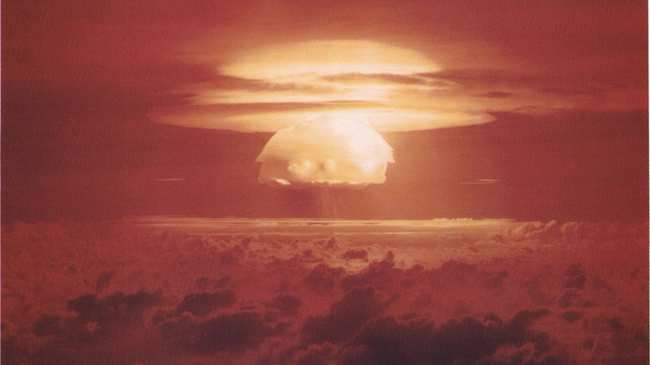America Is Not Prepared for Nuclear War, Public Health Experts Warn
A gathering of experts organized by the National Academies of Sciences, Engineering, and Medicine said the US isn’t ready for the public health crisis that would follow a nuclear blast.

Image: US Department of Energy
North Korea has nuclear weapons and the world is closer to nuclear war now than it has since the Cold War—and Americans are not ready for the fallout, experts say. As first reported by Nature, America’s National Academies of Sciences, Engineering, and Medicine organized a meeting of health experts to discuss America’s ability to respond to the public health crisis that would follow a (hypothetical) nuclear detonation.
The conclusion was grim. “Now that thermonuclear [weaponry] is back on the table, we’re back to people saying, ‘We can’t deal with this,’” Cham Dallas, a public health researcher at the University of Georgia, told Nature.
Health care professionals across America need to fill in the knowledge gaps around radiological threats and burn wounds. Tener Veenema, a disaster nursing expert from Johns Hopkins, said the gathering was “an acknowledgement that the threat picture has changed, and that the risk of this happening has gone up.”
The US and its allies used to study the world’s ability to deal with an atomic blast, but that changed after the Cold War ended and tensions eased with Russia. Stategists started to think that the next nuclear attack might come from smaller bombs developed from stolen or lost fissile material.
Then North Korea changed the game in 2006 when it successfully detonated a nuclear bomb and put everyone back on Cold-War footing.
Read More: We Asked a Doomsday Clock Scientist About Trump's 'Fire and Fury' Threat
To get an idea of what the fallout of a nuclear attack might look like, experts often look to past crises: how Japan dealt with the Fukushima reactor meltdown in 2011, and how Russia dealt with the Chernobyl disaster in 1986. The problems of wrecked infrastructure and millions dead are immediate, but the irradiated zones around the blast are a public health problem that lingers for years.
First responders at Fukushima and Chernobyl exposed themselves to tremendous levels of radiation to tend to the wounded, often puttings themselves in harm’s way. Dallas cited a 2017 study indicating that upwards of a third of responding medical professionals refused to enter an irradiated zone to render care because of the health risks involved. The same study also noted that most medical first responders have no training in how to deal with the aftermath of a nuclear attack.
The experts are worried, but America isn’t exactly resting on its laurels. Hawaii has been preparing for the possibility of a nuclear first strike from North Korea for years. The US Center for Disease Control hosted a workshop about the public health response to a nuclear disaster in January, and makes resources available online about how to respond to a radiological event.
Fear and ignorance will kill you as fast as nukes will, if you manage to survive the initial blast. These weapons have only been detonated over a civilian population twice, and they’ve changed dramatically in the 70 years since.
The best thing an average citizen can do is educate themselves on basic first-aid procedures and, if they live in a major metropolitan area, have a plan for sheltering in the event of a nuclear attack. “Make sure you have an Emergency Supply Kit for places you frequent and might have to stay for 24 hours,” Ready.gov, a government-run website that helps people prepare for disasters, says. “It should include bottled water, packaged foods, emergency medicines, a hand-crank or battery-powered radio to get information in case power is out, a flashlight, and extra batteries for essential items. If possible, store supplies for three or more days.”
No comments:
Post a Comment